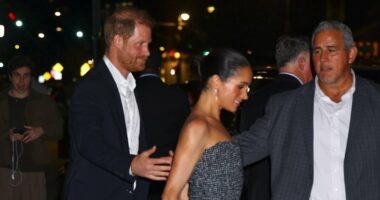Share this @internewscast.com
A royal insider has revealed the hilarious quip the Queen Mother made towards King George VI after the public continuously cheered for the royals to wave from the palace.
The then-king and queen were celebrating their silver wedding when hundreds of well-wishers packed out the Mall to catch a glimpse of the happy couple.
However, the royal fans were somewhat over-enthusiastic and kept asking the Royal Family to make their traditional appearance on the balcony of Buckingham Palace.
But they didn’t ask the family to appear just once – rather, a whopping nine times.
Writing in his biography of the Queen Mother, royal author Hugo Vickers revealed that after the eighth appearance King George VI complained: ‘Why can’t they leave us alone?’
To which the Queen Mother cheekily responded: ‘One day they might not want us,’ before they once again ventured out to greet the onlookers.
The then-Queen Elizabeth and King George VI appearances on the balcony capped off an eventful day of celebrations to mark their 25th wedding anniversary.
In the morning of April 26, 1948, the Royal Family first travelled to St Paul’s Cathedral for a thanksgiving service from the Archbishop of Canterbury.

The Royal Family wave from the balcony of Buckingham Palace during King George VI and Queen Elizabeth’s silver wedding anniversary. The royal fans were somewhat over-enthusiastic and cheered the royals to come out nine times

After the eighth appearance on the balcony King George VI complained: ‘Why can’t they leave us alone?’ To which the Queen Mother cheekily responded: ‘One day they might not want us,’ before they once again ventured out to greet the onlookers

The king and queen wave onlookers during the celebration of their silver wedding anniversary
During the sermon the Archbishop made reference the family’s ‘own share of domestic griefs and burdens’ – perhaps a subtle reference to the drama that engulfed the royals during the abdication crisis when King Edward VIII stood down to marry twice-divorced Wallis Simpson.
George and Elizabeth were joined in the church by all the leading members of the Royal Family, including Princess Elizabeth with her husband Philip, Princess Margaret and Queen Mary.
Afterwards, the family were driven in an open carriage through the streets of London so that the king and queen could wave at onlookers, before they returned to Buckingham Palace to continue the festivities.
Here, the family enjoyed a decorative cake emblazoned with the coat of arms.
Their actual wedding in 1923 was ironically a somewhat quieter affair.
This was because George did not at this moment expect to inherit the Crown and so his wedding was more low-key than if he had been heir to the throne.
Even so, royals from around Europe gathered for the event.
Among them were King Alfonso XIII and Queen Ena of Spain, King Haakon VII and Queen Maud of Norway and Queen Marie of Romania.
Nevertheless, it was a memorable matrimony which broke a lot of conventions.

A photograph of King George VI and Queen Elizabeth to mark their 25th wedding anniversary

The then-king and queen at St Paul’s during their wedding anniversary. During the sermon the archbishop made reference the family’s ‘own share of domestic griefs and burdens’ – perhaps a subtle reference to the drama that engulfed the royals during the abdication crisis

decorative wedding cake emblazoned with the coat of arms

King George VI and Queen Elizabeth pass onlookers on the way back to the palace from St Paul’s on their silver wedding anniversary
Elizabeth – while still a member of aristocracy – was not what the Windsors would have considered marriage material at a time when British princes traditionally married princesses from continental Europe.
But the wedding was allowed to go ahead in the spirit of political modernisation and because the then-Prince Albert was only the spare.
The soon-to-be princess then took the 1,800 guests at Westminster Abbey by surprise when she unexpectedly laid her bouquet at the Tomb of the Unknown Soldier in a tribute to her brother, Fergus, who died in the First World War.
Her dress was very much in the fashion of the 1920s, made from silk and embroidered with pearls and beads.
Dressmaker Elizabeth Handley-Seymour, designed the piece, which boasted a train from both the waist and shoulders.
Elizabeth, like Queen Victoria, wore a coronet of orange blossom instead of her tiara.
In keeping with the theme of modernity, the newly formed BBC asked for permission to broadcast the ceremony over the radio.

Lady Elizabeth with her parents the Earl and Countess of Strathmore (left) and the Duke of York’s parents King George V and Queen Mary (right)

Prince Albert, the Duke of York and future King George VI, and Lady Elizabeth Bowes-Lyon on their wedding day on April 26, 1923
However, the Archbishop of Canterbury, Randall Davidson, objected to the proposal out of concern that ‘men might listen to it in public houses’.
It was, however, filmed on silent newsreel which gives a glimpse into the day of the wedding.
In the footage, Elizabeth can be seen leaving Bruton Street, in Mayfair, on her way to the Abbey and getting into a horse-drawn carriage.
Later on, the newly married couple can be seen on the balcony of Buckingham Palace – surrounded by the Royal Family – as they wave to their well-wishers.
The future King and Queen’s journey down the aisle was far from a straightforward.
When George first proposed to Elizabeth in 1921, she turned him down due to her misgivings about royal life.
In response, Elizabeth told him afterwards in a letter: ‘It makes me so miserable to think of it – you have been so very nice about it all – please do forgive me.’
His second proposal came in March 1922, but again he was rebuffed.

The Daily Mail’s coverage of the wedding included photographs of the bridesmaids and other leading figures at the ceremony

The wedding was filmed on silent newsreel which gives a glimpse into the day. In the footage the newly married couple can be seen on the balcony of Buckingham Palace
Telling him he was one of her ‘best & most faithful friends’, she said she was ‘so terribly sorry about what happened yesterday’.
The Duke was now in despair, fearful that the only woman he wanted to marry may never agree.
However, the pair continued seeing each other, including at successive shooting weekends at Glamis and Elizabeth’s English family home, St Paul’s Walden Bury in Hertfordshire.
Friends and acquaintances were now aware that the Prince was in love with Elizabeth.
In January 1923, he took her to dinner and again proposed, having told his friend the Duchess of Devonshire that it would be ‘the last time’ that he would do so.
This time, she said she needed time to think about it.
It was during another shooting weekend at St Paul’s Walden Bury that she finally said yes.
Writing to a friend, she said: ‘I feel terrified now that I’ve done it – in fact no one is more surprised than me.’

A postcard celebrating the wedding of Prince Albert, later King George VI, and Elizabeth Bowes-Lyon

The Duke and Duchess of York leave Buckingham Palace for their honeymoon
On the day that news of their engagement appeared in the Press, a member of the household at St Paul’s told the Daily Mail: ‘The engagement was a great surprise to everybody here.
‘It was pretty well known that the Duke was very, very fond of Lady Elizabeth, but as to her feelings towards him little was known.
‘Last weekend, though, after the proposal, she was all smiles and it was easy to see that she was very happy indeed.
‘Everybody in the neighbourhood is tremendously glad, for Lady Elizabeth is such a sweet girl and everybody loves her.’
By 1930 they had two daughters, Princess Margaret, born that year, and Princess Elizabeth, born in 1926. They had largely settled into life as the spare, assuming the Crown would never be placed atop of the duke’s head.
But destiny had other plans when, following King George V’s death, King Edward VIII’s desire to marry American divorcee Wallis Simpson sparked the biggest constitutional crisis in centuries.
Bertie found himself thrust on to the throne when Edward abdicated for the union. The Duke and Duchess of York then became King George VI and and Queen Elizabeth and their daughters became heir and spare.
King George’s reign was one that saw the brutal upheaval of the Second World War – and by his side throughout was Elizabeth.

George VI and the Queen on their honeymoon. Integral to the success of the King’s reign was the deep bond he shared with his wife
At the outbreak of war in 1939, there were suggestions that the Queen and her daughters could be evacuated to Canada. But a defiant Elizabeth shut this rumour down by saying: ‘The children won’t go without me. I won’t leave the King. And the King will never leave.’
The Royal Family therefore lived through the Blitz alongside the rest of London.
After the war, the King and Queen faced the challenge of uplifting a population that had been battered and bruised.
While King Edward had been regarded by figures such as Archbishop of Canterbury Cosmo Gordon Lang as desperately unsuited to be King – which he demonstrated during his ten tumultuous months on the throne – George emerged as a successful and much-loved monarch.
Integral to this success was the deep bond he shared with his wife, a woman who became a loyal lieutenant to her daughter when she inherited the throne after George’s death in 1952.
Despite the sadness of his loss aged 56, the Queen Mother would commit herself to royal duties for much of the rest of her own life – demonstrating how the initial doubts she had about entering royal service were misplaced.








